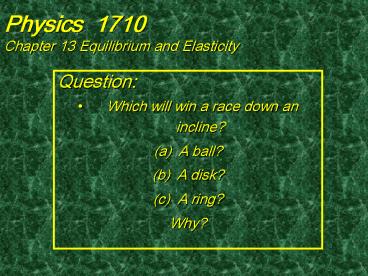Physics 1710 Chapter 13 Equilibrium and Elasticity - PowerPoint PPT Presentation
1 / 12
Title:
Physics 1710 Chapter 13 Equilibrium and Elasticity
Description:
Static equilibrium (no translational or rotational acceleration) ... Legends of the Fall How a ladder stays up. Fnet = 0. Fnet = 0. Tnet = 0. Physics 1710 ... – PowerPoint PPT presentation
Number of Views:995
Avg rating:3.0/5.0
Title: Physics 1710 Chapter 13 Equilibrium and Elasticity
1
Physics 1710Chapter 13 Equilibrium and
Elasticity
- Question
- Which will win a race down an incline?
- A ball?
- A disk?
- A ring?
- Why?
2
Physics 1710Chapter 13 Equilibrium and
Elasticity
- 1' Lesson
- Static equilibrium (no translational or
rotational acceleration) requires that all forces
and torques to balance. - If the acceleration due to gravity is the same
for all particles comprising a body the center of
mass is the center of gravity. - The moduli of elasticity characterizes the
stress-strain relation - stress modulus x strain
3
Physics 1710Chapter 13 Equilibrium and
Elasticity
- Equilibrium
Equilibrium means balanced. Fnet d P/dt In
equilibrium Fnet 0 Tnet d L/dt In
equilibrium Tnet 0
4
Physics 1710 Chapter 13 Equilibrium and
Elasticity
- Legends of the FallHow a ladder stays up
Fnet 0
Tnet 0
Fnet 0
5
Physics 1710 Chapter 13 Equilibrium and
Elasticity
- Center of Gravity
- If the acceleration due to gravity is the same
for all parts of a body, then the center of mass
corresponds to the center of gravity. - Proof Ti Sxi Fgi Sxi gmgi Mg Sxi mgi
/M Fcg xcm
6
Physics 1710 Chapter 13 Equilibrium and
Elasticity
- Elasticity
- Stress the deforming force per unit area.
- Strain the unit deformation.
- Tensile stretch
- Compressive squeeze
- Shear lean
- Hydraulic pressure
- Yield permanently deformed
7
Physics 1710 Chapter 13 Equilibrium and
Elasticity
- Elasticity
- Stress the deforming force per unit area.
- Strain the unit deformation.
- Stress modulus x strain
- s F/A Y e
8
Physics 1710 Chapter 13 Equilibrium and
Elasticity
- Elasticity
- Stress the deforming force per unit area.
- Strain the unit deformation.
- Stress modulus x strain
- s F/A Y e
9
Physics 1710 Chapter 13 Equilibrium and
Elasticity
- Elasticity
- Stress the deforming force per unit area.
- Strain the unit deformation.Tensile/Compressive
, Youngs Modulus E - Stress modulus x strain
- s F/A E e E ?L/L
?L
L
s
10
Physics 1710 Chapter 13 Equilibrium and
Elasticity
- Elasticity
- Stress the deforming force per unit area.
- Strain the unit deformation.Shear Modulus G
- Stress modulus x strain
- s F/A G e G ?x/L
L
?x
s
11
Physics 1710 Chapter 13 Equilibrium and
Elasticity
- Elasticity
- Stress the deforming force per unit area.
- Strain the unit deformation.Hydraulic Stress
Bulk Modulus B - Stress modulus x strain
- s F/A p B e B ?V/V
?V
V
p
12
Physics 1710 Chapter 13 Equilibrium and
Elasticity
- Summary
- Static equilibrium imples that all forces and
torques balance. - The center of mass is often the center of
gravity. - The moduli of elasticity characterizes the
stress-strain relation - stress modulus x strain
- Stress modulus x strain
- s F/A Y e

